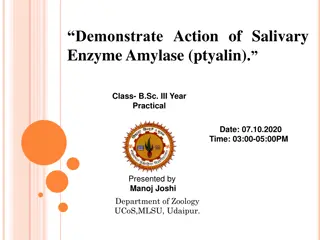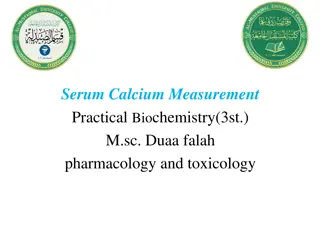Serum Amylase: Functions, Testing & Symptoms
Serum amylase is an enzyme pivotal in carbohydrate digestion, produced mainly by the pancreas and salivary glands. Learn about its functions, testing methods, and associated symptoms like abdominal pain, fever, and more. Discover why testing is crucial to diagnose pancreatic disorders such as pancreatitis and monitor pancreatic health.
Download Presentation

Please find below an Image/Link to download the presentation.
The content on the website is provided AS IS for your information and personal use only. It may not be sold, licensed, or shared on other websites without obtaining consent from the author.If you encounter any issues during the download, it is possible that the publisher has removed the file from their server.
You are allowed to download the files provided on this website for personal or commercial use, subject to the condition that they are used lawfully. All files are the property of their respective owners.
The content on the website is provided AS IS for your information and personal use only. It may not be sold, licensed, or shared on other websites without obtaining consent from the author.
E N D
Presentation Transcript
Serum Amylase Muthana Al-Shemeri Lab. Assistants, Mr Jamal Abdulfattah Mrs Ferdws
amylase [am-ls] An enzyme synthesised in the pancreas and salivary glands and secreted in the GI tract which digests starch and glycogen. Structure
-amylase production Amylase is one of several enzymes produced by the pancreas to help digest carbohydrates. Amylase is secreted through the pancreatic duct into the first part of the small intestine (duodenum), where it helps break down dietary carbohydrates. It is also produced by other organs, particularly the salivary glands.
Functions The main function for this enzyme is catalyzes the hydrolysis of starch into simpler compounds. Types 1 - the -amylases occur in animals. found in saliva, pancreatic juice, certain bacteria, and mold, catalyzes the hydrolysis of starches to dextrins, maltose, and maltotriose. 2 - the -amylases occur in higher plants. Found in grains, vegetables and bacteria. It is involved in the hydrolysis of starch to maltose.
Signs and symptoms When you have symptoms of a pancreatic disorder, such as 1- Severe abdominal pain, 2- Fever, 3- Loss of appetite, or 4- Nausea.
Why get tested? Primarily to diagnose and monitor Acute pancreatitis, Chronic pancreatitis or Other pancreatic diseases like pancreatic tumor in rare cases, increased amounts of amylase are released into the blood. This increases concentrations of amylase in the blood will also present in the urine as amylase is eliminated from the blood through the urine.
Measurement of serum - amylase It is measured in patients with suspected pancreatitis: serum and urine levels peak 4 8 hours after onset of acute pancreatitis, and normalise within 48 72 hours. -amylase activity is an important diagnostic test for acute and chronic pancreatitis. Normal blood findings are 56 to 190 IU/L.
-Amylase readings High increase: Acute pancreatitis, severe glomerular dysfunction (low amylase clearance), pancreatic cancer, acute salivary gland disease, severe diabetic ketoacidoses. amylase in the blood often increases to 4 to 6 times higher than the highest reference value, sometimes called the upper limit of normal. The increase occurs within 4 to 8 hours of injury to the pancreas and generally remains elevated until the cause is successfully treated. Then the amylase values will return to normal in a few days.
Moderate increase: Abdominal disturbance, salivary gland disorders. In chronic pancreatitis, amylase levels initially will be moderately elevated but often decrease over time with progressive pancreas damage. In this case, levels returning to normal may not indicate that the source of damage has been resolved.
Low -amylase: New born up to 1 year (physiological). Symptoms of low amylase may indicate permanent damage to the amylase-producing cells in the pancreas. Decreased levels can also be due to kidney disease and toxemia of pregnancy.























